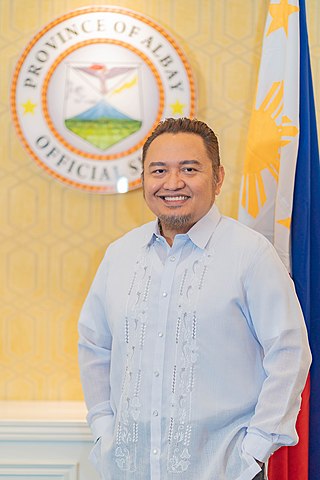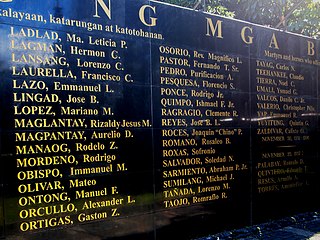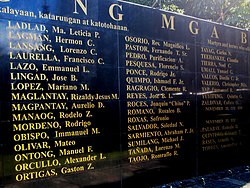
Filemon Castelar Lagman, popularly known as Ka Popoy, was a revolutionary socialist and workers' leader in the Philippines. He shares the ideology of Marxism-Leninism. He split with the Communist Party of the Philippines in 1991 to form Bukluran ng Manggagawang Pilipino (BMP) and the multi-sectoral group Sanlakas.

Haydee Bofill Yorac was a Filipina public servant, law professor and politician.

Edcel Castelar Lagman Sr. is a Filipino human rights lawyer and politician from the province of Albay. He was elected as a member of the House in 1987 to 1998 and 2004 to 2013 and 2016 up to the present. He served as Minority Floor Leader of the House of Representatives of the Philippines until 2012, when he resigned the office. Lagman is one of the key Liberal Party figures in the House of Representatives, having supported the Responsible Parenthood and Reproductive Health Act, the SOGIE Equality Bill, the Free Tertiary Education Act, the Anti-Dynasty Bill, and the Freedom of Information Bill. He is also the principal author of the Divorce Bill, the Human Rights Defenders Bill, the Prevention of Teenage Pregnancy Bill, and the Anti-Child Marriage Bill.

Martial law in the Philippines refers to the various historical instances in which the Philippine head of state placed all or part of the country under military control—most prominently during the administration of Ferdinand Marcos, but also during the Philippines' colonial period, during the second world war, and more recently on the island of Mindanao during the administrations of Gloria Macapagal Arroyo and Rodrigo Duterte. The alternative term "martial law era" as applied to the Philippines is typically used to describe the Marcos martial law period specifically.

The governor of Albay is the chief executive of the provincial government of Albay, Philippines. Like all local government heads in the Philippines, the governor is elected via popular vote, and may not be elected for a fourth consecutive term. In case of death, resignation or incapacity, the vice governor becomes the governor.

The Free Legal Assistance Group (FLAG) is a nationwide organization of human rights lawyers in the Philippines. It was founded in 1974 by Sen. Jose W. Diokno, Lorenzo Tañada, J.B.L. Reyes, and Joker Arroyo during the martial law era under former President Ferdinand Marcos. It is the first and largest group of human rights lawyers established in the nation. They work on countering varied abuses against human rights and civil liberties. Its current chairman since 2003 is human rights attorney Chel Diokno, the founding dean of the De La Salle University Tañada-Diokno School of Law.
Communism in the Philippines emerged in the first half of the 20th century during the American Colonial Era of the Philippines. Communist movements originated in labor unions and peasant groups. The communist movement has had multiple periods of popularity and relevance to the national affairs of the country, most notably during the Second World War and the Martial Law Era of the Philippines. Currently the communist movement is underground and considered an insurgent movement by the Armed Forces of the Philippines.

The Bantayog ng mga Bayani, sometimes simply referred to as the Bantayog, is a monument, museum, and historical research center in Quezon City, Philippines, which honors the martyrs and heroes of the struggle against the dictatorship of former President Ferdinand Marcos.
Student activism in the Philippines from 1965 to 1972 played a key role in the events which led to Ferdinand Marcos' declaration of Martial Law in 1972, and the Marcos regime's eventual downfall during the events of the People Power Revolution of 1986.

Rizalina "Lina" Parabuac Ilagan was an anti-martial law activist who belonged to a network of community organizations in the Southern Tagalog region in the Philippines.

At 7:15 p.m. on September 23, 1972, President Ferdinand Marcos announced on television that he had placed the entirety of the Philippines under martial law. This marked the beginning of a fourteen-year period of one-man rule that would effectively last until Marcos was exiled from the country on February 25, 1986. Even though the formal document proclaiming martial law—Proclamation No. 1081, which was dated September 21, 1972—was formally lifted on January 17, 1981, Marcos retained essentially all of his powers as dictator until he was ousted.
Religious sector opposition against the dictatorship of President Ferdinand Marcos included leaders and workers belonging to different beliefs and denominations.
The dictatorship of Philippine President Ferdinand E. Marcos in the 1970s and 1980s is historically remembered for its record of human rights abuses, particularly targeting political opponents, student activists, journalists, religious workers, farmers, and others who fought against the Marcos dictatorship. Based on the documentation of Amnesty International, Task Force Detainees of the Philippines, and similar human rights monitoring entities, historians believe that the Marcos dictatorship was marked by 3,257 known extrajudicial killings, 35,000 documented tortures, 77 'disappeared', and 70,000 incarcerations.

During the presidency of Ferdinand Marcos, Filipino workers in the labor industry experienced the effects of government corruption, crony capitalism, and cheap labor for foreign transnational industries, One of the objectives of Martial Law was to cheapen labor costs, in order to attract transnational corporations to export labor to the Philippines. Marcos signed many presidential decrees beneficial only to his associates, while allowing for the forced relocation of indigenous peoples, decreasing workers' wages, and murders of labor activists. Minimum wage was a fixed PHP8.00 per day. Many workers were unemployed or underemployed. It was also during the Marcos presidency when the practice of contractualization began, enabling managements to avoid giving regular, permanent status to employees after six months of work. Strikes were banned and the government controlled trade unions, leaving workers without effective protection against employers who had unfair labor practices and regulations.

Melania Cristina Catalla was an anti-martial law activist who belonged to a network of community organizations in the Southern Tagalog region in the Philippines whose disappearance on July 31, 1977, became a rallying cry of the Philippine resistance against the Marcos dictatorship.

Aloysius “Ochie” Ureta Baes was a Filipino chemist, environmentalist, pro-democracy activist, educator and musician.

Gerardo T. Faustino was a Filipino student leader and activist from the University of the Philippines Los Baños who is best known as one of the most prominent desaparecidos of the Marcos Martial Law era in the Philippines.

Jacobo Sybico Amatong was a Filipino lawyer, politician, and newspaper publisher from the province of Zamboanga del Norte. He was best known for founding the Mindanao Observer, a community newspaper which became well-known for criticizing the martial law administration of Ferdinand Marcos, and for being assassinated by uniformed soldiers on September 24, 1984.

Maria Leticia Quintina Jimenez Pascual-Ladlad, also known by her nickname Tish, was a student journalist at the University of the Philippines Los Baños (UPLB) during the Marcos dictatorship, known for being the first woman editor-in-chief of the Aggie Green and Gold, for her community organizing work among farmers in Laguna and Quezon, and for being the first UPLB student to become a desaparecido during the Martial Law regime.

Edcel Greco Alexandre Burce Lagman, also known as Grex, is a Filipino lawyer and politician from the province of Albay.













